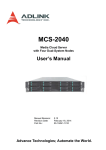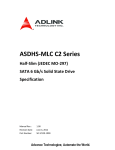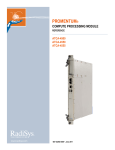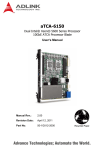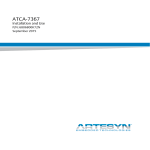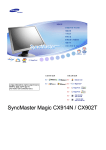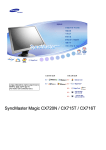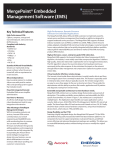Download aTCA-9300 User's Manual
Transcript
aTCA-9300 Dual Intel® Xeon® E3 1275V2/1225V2 AdvancedTCA Processor Blade User’s Manual Manual Revision: Revision Date: Part No.: 1.02 Preliminary April 15, 2013 50- 1G022-1000 Advance Technologies; Automate the World. Revision History Revision 1.00 1.01 1.02 Release Date January 4 , 2013 April 1, 2013 April 15, 2013 Description of Change(s) Preliminary release Correct 3.3.6.1 switch table Update Base and Fabric Channel LED indicators Copyright 2013 ADLINK Technology, Inc. All Rights Reserved. The information in this document is subject to change without prior notice in order to improve reliability, design, and function and does not represent a commitment on the part of the manufacturer. In no event will the manufacturer be liable for direct, indirect, special, incidental, or consequential damages arising out of the use or inability to use the product or documentation, even if advised of the possibility of such damages. This document contains proprietary information protected by copyright. All rights are reserved. No part of this manual may be reproduced by any mechanical, electronic, or other means in any form without prior written permission of the manufacturer. Trademarks Product names mentioned herein are used for identification purposes only and may be trademarks and/or registered trademarks of their respective companies. 2 Table Of Contents Revision History ......................................................................................................................2 1 Overview .............................................................................................................................5 1.1 Introduction .....................................................................................................................5 1.2 Block Diagram .................................................................................................................6 1.3 Package Contents ...........................................................................................................7 2 Specifications.....................................................................................................................8 2.1 aTCA-9300 Specifications...............................................................................................8 2.1.1 CPU/ Chipset/ Memory ...................................................................................................8 2.1.2 Standard and Interface ...................................................................................................8 2.1.3 Software .........................................................................................................................9 2.1.4 Mechanical & Environmental ..........................................................................................9 2.2 Power Consumption .....................................................................................................10 2.3 Board Layout .................................................................................................................11 2.3.1 aTCA-9300 Board Layout ............................................................................................. 11 2.3.2 Status LED Definitions ..................................................................................................14 2.4 Compliance ....................................................................................................................16 3 Functional Description ....................................................................................................17 3.1 CPU, Memory and Chipset............................................................................................17 3.1.1 CPU ..............................................................................................................................17 3.1.2 Memory.........................................................................................................................18 3.1.3 Intel® C216 Chipset Overview......................................................................................18 3.2 Peripherals.....................................................................................................................19 3.2.1 Reset ............................................................................................................................19 3.2.2 SMBus Devices ............................................................................................................20 3.2.3 GPIO List ......................................................................................................................21 3.3 I/O Interfaces .................................................................................................................22 3.3.1 USB ..............................................................................................................................22 3.3.2 VGA Interface ...............................................................................................................23 3.3.3 Ethernet Connection .....................................................................................................23 3.3.4 Serial Port.....................................................................................................................24 3.3.5 Onboard CFast Interface ..............................................................................................24 3.3.6 Switch And Jumper Settings .........................................................................................25 4 Intelligent Platform Management System ......................................................................26 4.1 IPMI Sensors..................................................................................................................26 4.1.1 Sensor Reading (FRU Hotswap Sensor) ......................................................................28 4.1.2 Get Sensor Reading (Physical IPMB-0 Sensor) ...........................................................28 4.1.3 Watchdog Timer Sensor ...............................................................................................30 4.1.4 Version Change Sensor................................................................................................31 4.1.5 Get Sensor Reading Command....................................................................................32 4.2 IPMI Commands ............................................................................................................33 5 Getting Started .................................................................................................................35 5.1 Safety Requirements.....................................................................................................35 5.2 Installing and Removing the aTCA-9300 .....................................................................36 3 5.2.1 Installing the Blade .......................................................................................................36 5.2.2 Removing the Blade .....................................................................................................40 5.3 Firmware Update Procedure.........................................................................................43 5.3.1 Update Over Serial Interface ........................................................................................43 5.3.2 Update over KCS..........................................................................................................44 5.3.3 Update over LAN...........................................................................................................45 6 BIOS ..................................................................................................................................47 6.1 Starting the BIOS...........................................................................................................47 6.1.1 Setup Menu...................................................................................................................47 6.1.2 Navigation .....................................................................................................................48 6.2 Main Setup .....................................................................................................................51 6.2.1 System & Board Info .....................................................................................................51 6.2.2 System Date/System Time ............................................................................................52 6.3 Advanced BIOS Setup ..................................................................................................52 6.3.1 CPU Configuration ........................................................................................................52 6.3.2 SATA Configuration .......................................................................................................54 6.3.3 USB Configuration ........................................................................................................55 6.3.4 H/W Monitor from IPMC ................................................................................................55 6.3.5 Super IO Configuration .................................................................................................56 6.3.6 Serial Port Console Redirection ....................................................................................57 6.3.7 Network Stack ...............................................................................................................60 6.3.8 CPU PPM Configuration ...............................................................................................61 6.4 Chipset Setup ................................................................................................................62 6.4.1 PCH-IO Configuration ...................................................................................................63 6.4.2 System Agent (SA) Configuration..................................................................................64 6.5 Boot Setup .....................................................................................................................65 6.5.1 CSM Parameter ............................................................................................................66 6.6 Security Setup ...............................................................................................................67 6.7 Save & Exit Menu ..........................................................................................................68 6.8 Server Mgmt Setup Screen...........................................................................................70 7 Serial Over LAN................................................................................................................71 7.1 Preparation For SOL Connection.................................................................................71 7.2 Configure The Remote Client .......................................................................................71 7.2.1 Install IPMItool For The Remote Client..........................................................................71 7.3 Configure The Target aTCA-9300.................................................................................72 7.3.1 BIOS Configuration .......................................................................................................72 7.3.2 Linux grub Setting .........................................................................................................72 7.3.3 Linux System Setting ....................................................................................................73 7.4 Establish SOL Connection ...........................................................................................73 8 Drivers...............................................................................................................................75 Safety Instructions ................................................................................................................76 Getting Service ......................................................................................................................77 4 1 Overview 1.1 Introduction The ADLINK aTCA-9300 is a high performance AdvancedTCA® (ATCA) processor blade featuring dual 4-core Intel® Xeon® processor E3 1275V2 /1225V2, Intel® C216 Chipset, four channel memory up to 32 GB of DDR3 memory and 300 W power supply subsystem. Versatile connectivity includes dual 10GbE Fabric Interfaces, dual GbE Base Interfaces, quad front panel GbE egress ports, front panel dual COM and USB 2.0 ports and front panel VGA connector. An onboard SATA connector supports CFast up to 32 GB and the optional RTM (aTCA-R6270/R6280) supports an 8-channel mini-SAS port, dual 10GbE SFP+ ports, dual USB ports and dual hot-swappable SATA bays providing additional network throughput and storage capacities. The aTCA-9300's thermal solution (including VRM heat sink) ensures stable operation under extreme operating environments and allows for compliance to the NEBS Level 3 standard (design only). The robust computing power and reliability of the aTCA-9300 meets the requirements of telecom equipment manufacturers (TEMs) and network equipment providers (NEPs), allowing them to build the next-generation telecom networks and communication infrastructures. Detailed features are outlined below and a functional block diagram is shown in the next section. Single Four-core Intel® Xeon® processor Xeon E3 1275V2/1225V2 or Core i3 3220 Server-class Intel® C216 Chipset DDR3-1600 JEDEC standard VLP UDIMM (REG/ECC), up to 32 GB Onboard bootable 16GB SATA Interface CFast card (max. 32GB) Six Intel® I210 Gigabit Ethernet controllers One Intel® 82599EB 10Gigabit Ethernet (XAUI) controller Optional Intel® 82599ES 10Gigabit Ethernet (SFP+) controller on RTM (aTCA-R6270) Optional dual SATA interface drive bays on RTM (aTCA-R6270) Optinal Dual 4 channel of mini SAS for external storage device(aTCA-RTM6280) Dual PICMG 3.1 Option 9 Fabric Interface channels Failover system BIOS Analog VGA output up to 1920x1440 resolution 5 1.2 Block Diagram 6 1.3 Package Contents Before opening, please check the shipping carton for any damage. If the shipping carton and contents are damaged, notify the dealer for a replacement. Retain the shipping carton and packing material for inspection by the dealer. Obtain authorization before returning any product to ADLINK. Check that the following items are included in the package. If there are any missing items, contact your dealer: aTCA-9300 AdvancedTCA processor blade (CPU, RAM specifications may differ depending on options selected) RJ-45 to DB-9 cable (for front panel serial port) SATA interface adapter board 7 2 Specifications 2.1 aTCA-9300 Specifications 2.1.1 CPU/ Chipset/ Memory CPU Single 4-core Intel® Xeon® processor E3 1275V2(2.1/1.8GHz QPI 8.0GT/s, 20MB L2 cache, LGA1155 socket) Chipset Memory Intel® C216 Chipset (Intel® BD82C216 Chipset) Registered ECC DDR3-1333/1600 VLP UDIMM Four UDIMM sockets Up to 32GB 2.1.2 Standards Networking Display USB Serial Storage Front Panel I/O Rear I/O on aTCA-R6270 Rear I/O on aTCA-R6280 Standard and Interface PICMG 3.0 R2.0 AdvancedTCA PICMG 3.1 AdvancedTCA Ethernet, Option 9 Six 10/100/1000BASE-T RJ-45 ports on face plate Two 10/100/1000BASE-T Base Interface channels Two 10GBASE-BX4 Fabric Interface channels via Intel® 82599EB ] 10G Ethernet Controller on aDB-6100-A riser card (Option 9) Two 10GBASE SFP+ ports on RTM (aTCA-R6270/R6280) Integrated HD Graphics with DirectX 11 Supports up to 1920 x 1440 resolution Two USB 2.0 ports on front panel, Two USB 2.0 ports to RTM One RS-232 ports on front panel (RJ-45) One RS-232 port to RTM Onboard SATA connector supports CFast up to 32GB Two SATA channels to RTM 1x VGA port (DB-15) 2x USB 2.0 port (Type-A) 1x RS-232 console port (RJ-45) 6 x GbE ports (RJ-45) LEDs: OOS, Media, User and Hotswap Recessed reset button 2x SFP+ ports (Intel® 82599ES 10G Ethernet Controller) 1x RS-232 port (RJ-45) 2x USB 2.0 ports 2x SATA ports from Intel® C216 Chipset 2x SFP+ ports (Intel® 82599ES 10G Ethernet Controller) 1x SATA ports from Intel® C216 Chipset 2x 4-channel mini-SAS port 8 2.1.3 Software BIOS Supported OS 2.1.4 AMI BIOS with 8Mbit flash memory Microsoft Windows Server 2008 Microsoft Windows Server 2008 R2 Red Hat Enterprise Linux 6.2/6.3 Contact ADLINK for other OS availability Mechanical & Environmental Dimensions Operating Temperature Storage Temperature Humidity Shock Vibration Compliance 322.25mm x 280mm x 30.48mm (H x D x W) - 6HP slot Standard: 0°C to 50°C NEBS short-term: 0°C to 61°C (sea level) -40°C to 85°C 5% to 90% non-condensing 15G peak-to-peak, 11ms duration, non-operation Non-operating: 1.88 Grms, 5 to 500 Hz, each axis Operating: 0.5 Grms, 5 to 500Hz, each axis CE, FCC Class A, CUL, NEBS Level 3 (design) 9 2.2 Power Consumption This section provides information on the power consumption of the aTCA-9300. System configuration (1) Memory: TS1GLK72W6HL 8GB DDR3-1600 ECC UDIMM (2) Graphics: Intel HD Graphics P4000 (3) Power Supply: Chroma DC Power supply 62012P-80-60 (4) CPU: Single 4-core Intel® Xeon® processor E3-1275V2 The following table lists power consumption under different operating systems and applications with a 48V power rail. OS and Application Power Consumption DOS 35.42 W Windows Server 2008 R2, idle 21.12 W Windows Server 2008 R2, BurnIn Test, CPU 100% usage 82.56 W 10 2.3 Board Layout 2.3.1 aTCA-9300 Board Layout 32 33 23 19 34 36 37 35 38 1 5 2 6 3 7 4 8 51 52 53 14 13 20 18 12 11 21 40 39 42 22 16 15 10 9 17 47 48 49 50 41 43 45 46 11 44 1 4 7 10 13 16 19 22 25 28 31 34 37 40 43 46 49 52 CN2 (RJ-45) CN5 (RJ-45) CX3 (SFP) U57 (GigaLan) U29 (GigaLan) U51 (GigaLan) U20 (Smart Fusion) BATTERY SW3 BIOS switch SW6 com/ IPMC function JP1 Clear CMOS J3 ZON3 AMC1 AP2 aTCA Key(B) J1E2 XDP (CPU) PSU2 DIMM3 CN0 (RJ-45) 2 5 8 11 14 17 20 23 26 29 32 35 38 41 44 47 50 53 CN3 (RJ-45) CX1 (SFP) CX4 (SFP) U38 (GigaLan) U23 (GigaLan) CPU Socket (1155) U25 (Clock Buffer) SPI Socket SW4 JTAG switch SW2 RTM Reset switch AP1 aTCA Key(RTM) J4 ZON3 BUZZER1 J5 ZON2 CN7 ZON1 DIMM1 DIMM4 COM1 12 3 6 9 12 15 18 21 24 27 30 CN4 (RJ-45) CX2 (SFP) U56 (GigaLan) U33 (GigaLan) U52 (GigaLan) PCH C216 U27 (Super I/O) JP2 GND_SH SW5 COM power switch JTAG Program Header 33 36 39 42 45 48 51 54 J2 RTM Power conn SATA1 Riser conn BCON1 Board to Board J1E1 XDP (PCH) PSU1 DIMM2 CN0_1 (RJ-45) VGA1 OOS LED HDD LED USER LED GbE (RJ-45) Reset Button RS-232 Serial Port VGA Hotswap LED USB Base and Fabric Channel LEDs 13 2.3.2 Status LED Definitions The following sections describe the front panel Status LEDs: Hot-swap LED, OOS LED, BIOS/OS Boot OK LED, IPMC Payload Power Authorized LED and IPMC Chassis Identify Command LED. 2.3.2.1 Out of Service (OOS) LED Out of Service LED (Red) Blinking Off On State During BIOS POST BIOS POST OK After OS shutdown Hot-swap LED Hot-swap LED (Blue) Off On Long blink Off Off Short blink Short blink FRU State number M0 M1 M2 M3 M4 M5 M6 FRU State Name FRU not installed FRU inactive FRU activation request FRU activation in process FRU active FRU deactivation request FRU deactivation in process 14 Remark M4 M4 M1 Base and Fabric Channel LED Base Channel and Fabric Channel LED Fabric 2 Speed and Link BCH2 Speed and Link 1Gbps – OFF 100 Mbps: Green 10Gbps – Orange 1Gbps: Orange Fabric 2 ACT (Green) BCH2 ACT (Green) Blink when accessing Blink when accessing Ethernet I/O Ethernet I/O Fabric 1 Speed and Link BCH1 Speed and Link 1Gbps - OFF 100 Mbps: Green 10Gbps – Orange 1Gbps: Orange Fabric 1 ACT (Green) BCH1 ACT (Green) Blink when accessing Blink when accessing Ethernet I/O Ethernet I/O 15 2.3.2.2 GbE LED LEFT LED: Speed and Link 1Gbps: Amber, 100Mbps: Orange RIGHT LED: ACT Blinking while data exchanging Color: Amber 2.4 Compliance The aTCA-9300 conforms to the following specifications: PICMG 3.0 R2.0 ECN0002 AdvancedTCA PICMG 3.1 Ethernet over AdvancedTCA Option 9 NEBS Level 3 (design) 16 3 Functional Description 3.1 CPU, Memory and Chipset 3.1.1 CPU The Intel® Xeon® processor E3 1275V2/E3 1225V2/Core i3 implements several key technologies: Two channels of DDR3 Unbuffered Dual In-Line Memory Modules (UDIMM) with a maximum of two DIMMs per channel Integrated I/O with up to 16 lanes for PCI Express Generation 3.0 8 /3MB of shared cache Streaming SIMD Extensions 2 (SSE2), Streaming SIMD Extensions 3 (SSE3) and Streaming SIMD Extensions 4 (SSE4) The Intel® Xeon® processor E3-1275V2 /E3-1225V2/ Core i3 supports several advanced technologies: Execute Disable Bit Intel® 64 Technology Enhanced Intel® SpeedStep® Technology Intel® Virtualization Technology (Intel® VT) Intel® Hyper-Threading Technology (Intel® HT Technology) The Intel® Xeon® processor E3 1275V2/ E3 1225V2 /Core i3 3220 has a maximum TDP of 77W/55W and has an elevated case temperature specification. The elevated case temperatures are intended to meet the short-term thermal profile requirements of NEBS Level 3. The Intel® Xeon® processor is ideal for thermally constrained form factors in embedded servers, communications and storage markets. Supported Processors, Maximum Power Dissipation The following table describes the Intel® Xeon® processor E5 family CPUs supported by the aTCA-9300: Name cache Clock QPI TDP E3 1275V2 8M 3.5GHz 8.0 GT/s 77W E3 1225V2 8M 3.2 8.0 GT/s 77W 17 Core i3 8MB 3.3GHz N/A 55W 3.1.2 Memory The aTCA-9300 adopts the Intel® Xeon® processor E3 (or Core™ i3) providing two memory channels supporting DDR3 800, 1066, 1333, and 1600 MT/s DIMMs. The maximum memory capacity is 32GB with memory interleaving support. The 400/533/667/800 MHz differential memory clocks are driven by the Intel® Xeon® processor E3 CPU with length-matching and impedance controlled through all the DIMM slots. The DDR3 DIMMs support the I2C interface. They are connected together and routed to the PCH for the management. Memory configuration changes are only permitted to be performed at the factory. Failure to comply with the above may result in damage to your board or improper operation. 3.1.3 Intel® C216 Chipset Overview The Intel® C216 Chipset provides a connection point between various I/O components and DMI based processors. Functions and capabilities include: Direct Media Interface Up to 20 Gb/s each direction Up to eight PCI Express root ports Supports PCI Express Rev 2.0 running at up to 5.0 GT/s Integrated Serial ATA Host Controller —Up to six SATA ports —Data transfer rates up to 6.0 Gb/s (600 MB/s) on up to two ports —Data transfer rates up to 3.0 Gb/s (300 MB/s) and up to 1.5 Gb/s (150 MB/s) on all ports —Integrated AHCI controller Intel® Rapid Storage Technology —Configures the PCH SATA controller as a RAID controller supporting RAID 0/1/5 Platform Environmental Control Interface (PECI) and Simple Serial Transport (SST) 1.0 Bus (Server and Workstation Only) supporting up to fourteen external USB 2.0 ports Power Management Logic —Supports ACPI 4.0a —ACPI-defined power states (processor driven C states) —ACPI Power Management Timer —SMI# generation —All registers readable/restorable for proper resume from 0 V core well suspend states —Support for APM-based legacy power management for non-ACPI implementations Integrated Clock Controller —Full featured platform clocking without need for a discrete clock chip —Ten PCIe 2.0 specification compliant clocks, four 33 MHz PCI clocks, four Flex Clocks that can be configured for various crystal replacement frequencies, one 120 MHz clock for embedded DisplayPort* —Two isolated PCIe* 2.0 jitter specification compliant clock domains Enhanced DMA Controller Supports LPC DMA Supports SMBus 2.0 Specification Real-Time Clock Serial Peripheral Interface (SPI) 18 —Supports up to two SPI devices —Supports 20 MHz, 33 MHz, and 50 MHz SPI devices Firmware Hub I/F supports BIOS Memory size up to 8 MB Low Pin Count (LPC) I/F Analog Display (VGA) 3.2 Peripherals The following peripherals are available on the aTCA-9300 blade 3.2.1 Reset The aTCA-9300 is automatically reset by a precision voltage monitoring circuit that detects a drop in voltage below the acceptable operating limit of 4.85V for the 5V line and below 3.2V for the 3.3V line. Other reset sources include the Watchdog Timer, the face plate push-button switch and also the RESET signal from the IPMC. The aTCA-9300 responds to any of these sources by initializing local peripherals. A reset will be generated by the following conditions: Power failure, +5 V supply falls below 4.1 V (typ.) or +3.3 V supply falls below 2.93 V (typ.) Pushbutton "RESET" pressed Watchdog time-out IPM controller reset 19 3.2.2 SMBus Devices The aTCA-9300 provides a System Management Bus (SMBus) hosted by the Intel® C216. The topology is shown in the diagram below. PECI 1.1 HOST IPMB A_SMbus IPMB B_SMbus IPMC Smart Fusion A2F500 RTM_SMbus Bac k planc e C onnec tor IPMB B_SMbus Hot Sw ap Buffer LTC4300 AMC_SMbus Adv anc ed M ez z anine C ard IPMB A_SMbus I2CCLK_IPM R is er C ard Zon1 Power Bac k planc e C onnec tor 0x56h Zon1 IPMB SMbus_Host MAX6618 HW MONITOR 0x90h I2C Bus LM73 NS Zon3 RTM close PCH 0x92h LM73 NS close PSU1 0x94h LM73 NS IPMC Latch Buffer 0x40h 0xA6h PCA9555 AT24C256 ICS9ZX21901 clock buffer INTEL SMbus_Host PCA9515 Host_SMbus W83627 C216 XDP 20 close CPU I2C Address EEPROM AMC 0xAAh AT24C256 B to B 3.2.3 GPIO List The following table summarizes GPIO usage on the Intel® C216 Chipset Name GPIO0 GPIO1 GPIO2 GPIO3 GPIO4 GPIO5 GPIO6 GPIO7 GPIO8 GPIO9 GPIO10 GPIO11 GPIO12 GPIO13 GPIO14 GPIO15 GPIO16 GPIO17 GPIO18 GPIO19 GPIO20 GPIO21 GPIO22 GPIO23 GPIO24 GPIO25 GPIO26 GPIO27 GPIO28 GPIO29 GPIO30 GPIO31 GPIO32 GPIO33 GPIO34 GPIO35 GPIO36 GPIO37 Power Well Default 3.3V 3.3V 5 V 5 V 5 V 5 V 3.3V 3.3V 3.3V 3.3V_SB 3.3V_SB 3.3V_SB 3.3V_SB 3.3V_SB 3.3V_SB 3.3V_SB 3.3V 3.3V GPI GPI GPI GPI GPI GPI GPI GPI GPI Native Native Native GPI GPI Native GPI GPI GPI 3.3V 3.3V 3.3V 3.3V 3.3V 3.3V_SB GPI GPO GPI GPI Native GPI 3.3V_SB 3.3V_SB 3.3V_SB 3.3V_SB 3.3V_SB 3.3V 3.3V 3.3V 3.3V 3.3V 3.3V GPI GPI GPI Native GPI GPI Native GPI GPO GPI Native Description Name GPIO38 GPIO39 GPIO40 GPIO41 GPIO42 GPIO43 GPIO44 GPIO45 GPIO46 Unused (PU) Unused (PU) Unused (PU) Unused (PU) Unused (PU) Unused (PU) Unused (PU) Unused (PU) Unused (DM) USB_OC-L5(PU) GPIO47 GPIO48 GPIO49 GPIO50 GPIO51 GPIO52 GPIO53 GPIO54 GPIO55 GPIO56 GPIO57 GPIO58 GPIO59 GPIO60 GPIO61 GPIO62 GPIO63 GPIO64 GPIO65 GPIO66 GPIO67 GPIO68 GPIO69 GPIO70 GPIO71 GPIO72 GPIO73 GPIO74 GPIO75 USB_OC-L6(PU) SMB_ALERT-L(PU) Unused (PU) SIO_PME-L Unused (PU) Unused (PU) SATA_GP4(PU) Unused (PU) SATA_GP1 (SPI MODE) PCIR_CLKRQ2-L SATA_GP0 Unused (PU) Unused (TP) H_SKTOCC-L(PU) Unused (PU) Unused (PU) Unused (PU) SUSACK-L/GPIO30 (PU) Unused (PU) SSB_GP32(PU) Unused (PU) Unused (PU) SSB_GP35(PU) Unused (DM) Unused (reserve PU) 21 Power Well Default 3.3V 3.3V 3.3V_SB 3.3V_SB 3.3V_SB 3.3V_SB 3.3V_SB 3.3V_SB 3.3V_SB GPI GPI Native Native Native Native GPO GPO GPO 3.3V 3.3V 3.3V 3.3V 3.3V 3.3V 3.3V 3.3V GPI Native GPI GPI GPI Native GPI Native 3.3V_SB 3.3V_SB 3.3V_SB 3.3V_SB 3.3V_SB 3.3V_SB 3.3V_SB 3.3V 3.3V 3.3V 3.3V 3.3V 3.3V 3.3V 3.3V 3.3V_SB GPI Native Native Native Native Native Native GPO GPO GPO GPO GPI GPI GPI GPI GPI 3.3V_SB 3.3V_SB Native Native Description Unused (PU) Unused (PU) USB_OC-L1(PU) USB_OC-L2(PU) USB_OC-L3(PU) USB_OC-L4 PCIR_CLKRQ5-L PCIR_CLKRQ6-L PCIR_CLKRQ7-L Unused (PU) Unused (DM) P_REQ1(PU) P_GNT1(DM) (SPI MODE) P_REQ2 (PU) Unused (TP) P_REQ3(PU) Unused (TP) Unused (PU) SML1_CLK (PU) USB_OC-L0 (PU) SMB0_ALERT-L (PU) Unused (TP) Unused (TP) SLP_S5-L CLK_48MHz Unused (TP) Unused (TP) Unused (TP) Unused (PU) Unused (PU) Unused (PU) Unused (PU) Unused (PU) SMB1_ALERT-L (PU) SML1_DAT (PU) 3.3 I/O Interfaces 3.3.1 USB The aTCA-9300 supports four USB 2.0 ports: Two Type-A ports on front panel Two ports routed to RTM On the USB 2.0 front panel port, a USB cable up to 5 meters in length can be used. On the USB 2.0 Rear I/O ports, it is strongly recommended to use a cable less than 3 meters in length for USB 2.0 devices. The USB 2.0 ports are high-speed, full-speed, and low-speed capable. Hi-speed USB 2.0 allows data transfers of up to 480 Mb/s, 40 times faster than a full-speed USB (USB 1.1). One USB peripheral may be connected to each port. With the aTCA-R6270 (RTM), the aTCA-9300 supports two additional USB ports on the I/O panel of the RTM. USB Connector Pin Definition (Type A) Pin Signal 1 2 3 4 5V USB VCC USBUSB+ GND USB Note: The aTCA-9300 host interfaces can be used with a maximum 500mA continuous load current as specified in the Universal Serial Bus Specification, Revision 2.0. Short circuit protection is provided. All the signal lines are EMI filtered. 22 3.3.2 VGA Interface A DB-15 female connector on the front panel provides analog display output. Front Panel VGA Pin Definition (DB-15) Pin 1 2 3 4 5 6 7 8 3.3.3 Name RED GREEN BLUE NC GND GND GND GND Pin 9 10 11 12 13 14 15 Name +5v GND NC DDC_DATA HSYNC VSYNC DDC_CLK Ethernet Connection The aTCA-9300 is equipped with one quad-port Intel® I350 AM4 Gigabit Ethernet Controller and one dual-port Intel® 82576EB Gigabit Ethernet Controller which provide six GbE ports in total. In default configuration, four ports from the Intel® I350 AM4 Gigabit Ethernet Controller are connected to the front panel RJ-45 ports. Two GbE ports from the Intel® 82576EB Gigabit Ethernet Controller are connected to Zone 2 Base Channels 1 and 2 (BCH1/BCH2). The aDB-6100-A Fabric riser card is installed on the aTCA-9300 by default and provides support for different configurations of Fabric Channels 1 and 2. Equipped with an Intel® 82599EB Ethernet controller, the riser card provides two 10GbE links to Fabric Channels 1 and 2 (FCH1/FCH2). With the aTCA-R6270 RTM installed, the aTCA-9300 supports dual 10GbE SFP+ ports from the Intel 82599ES Network Interface Controller connected to the PCIe x8 bus of CPU1. Front Panel GbE Pin Definition (RJ-45) Pin 1 2 3 4 5 6 7 8 GbE Signal Names Transmit Data1 + Transmit Data1 Receive Data2 + Receive Data3 + Receive Data3 Receive Data2 + Transmit Data4 + Transmit Data4 - 23 3.3.4 Serial Port Two serial ports are output to USB Mini-B connectors on the front panel for use as service terminals . The port labeled IPMI is an "IPMC" debug port and the port labeled CPU" is connected to COM 1 of the Super IO chip. Serial Port Pin Definition (USB Mini-B) 3.3.5 PIN Signal Name 1 2 3 4 5 Signal Ground Transmitted Data (TxD) Received Data (RxD) Signal Ground Signal Ground In/Out Out In Onboard CFast Interface The aTCA-9300 has one 17-pin CFast connector reserved for onboard mounting of a disk The connecotor pin list is shown as below. Signal Name JTAG_TCK JTAG_TDO JTAG_TMS VPUMP JTAG_TDI JTAG_TCK JTAG_TDO JTAG_TMS VPUMP JTAG_TDI JTAG_TCK JTAG_TDO JTAG_TMS VPUMP JTAG_TDI JTAG_TCK JTAG_TDO JTAG_TMS VPUMP JTAG_TDI JTAG_TCK JTAG_TDO JTAG_TMS VPUMP 24 Pin S1 S2 S3 S4 S5 S6 S7 P1 P2 P3 P4 P5 P6 P7 P8 P9 P10 P11 P12 P13 P14 P15 P16 P17 3.3.6 Switch And Jumper Settings 3.3.6.1 Set Blade Operation Mode Use switch SW3 to set the Blade Operation Mode. Normal operation requires a shelf manager for the blade to boot. Standalone mode allows the blade to boot without a shelf manager. SW3 Blade Operation Normal Mode (default) Standalone Mode 3.3.6.2 Pin 1 OFF OFF Pin 2 OFF OFF Pin 3 OFF ON Pin 4 OFF OFF IPMC JTAG Signal The switch SW4 is designed for hardware debug purposes. Do not change the default settings. Doing may result in an abnormal boot, failure to boot, and or damage to the board. SW12 IPMC JTAG Default Setting 3.3.6.3 Pin 1 OFF Pin 2 ON Pin 3 ON Shelf/Logic Ground Jumper Use JP2 to short Shelf Ground to Logic Ground. Shelf/Logic GND Shorted Open (default) JP2 Setting 1-2 2-3 The locations of SW3, SW4 and JP2 are shown below: JP2 SW3/4 25 Pin 4 ON 4 Intelligent Platform Management System The purpose of the intelligent platform management system is to monitor, control, and assure proper operation of AdvancedTCA® Boards and other Shelf components. The intelligent platform management system watches over the basic health of the system, reports anomalies, and takes corrective action when needed. The intelligent platform management system can retrieve inventory information and sensor readings as well as receive event reports and failure notifications from Boards and other Intelligent FRUs. The intelligent platform management system can also perform basic recovery operations such as reset of managed entities. The IPMC controller on aTCA-9300 supports an “intelligent” hardware management system, based on the Intelligent Platform Management Interface Specification. The intelligent management system provides the ability to manage the power, cooling, and interconnect needs of intelligent devices; to monitor events; and to log events to a central repository. 4.1 IPMI Sensors The following table lists all the sensors supported by the aTCA-9300. (1) (2) (3) (4) (5) (6) Hot Swap AMC Hot Swap RTM Hot Swap Version change IPMB Physical BMC Watchdog Sensor Address (0x0) (0x1) (0x2) (0x3) (0x4) (0x5) (7) +1.5V P_VDDQ (0x6) (8) +5.0V (0x7) (9) +3.3V (0x8) Item Sensor Name Description FRU Hotswap Sensor. AMC Hotswap Sensor. RTM Hotswap Sensor. Version Change Sensor. Physical IPMB Sensor. Watchdog Timer Sensor. Voltage Sensor. Upper Non-Recoverable Threshold = 1.65 Volts Upper Critical Threshold = 1.62 Volts Upper Non-Critical Threshold = 1.59 Volts Lower Non-Critical Threshold = 1.296 Volts Lower Critical Threshold = 1.242 Volts Lower Non-Recoverable Threshold = 1.215 Volts Voltage Sensor. Upper Non-Recoverable Threshold = 5.5 Volts Upper Critical Threshold = 5.4 Volts Upper Non-Critical Threshold = 5.3 Volts Lower Non-Critical Threshold = 4.7 Volts Lower Critical Threshold = 4.6 Volts Lower Non-Recoverable Threshold = 4.5 Volts Voltage Sensor. Upper Non-Recoverable Threshold = 3.63 Volts Upper Critical Threshold = 3.564 Volts Upper Non-Critical Threshold = 3.498 Volts Lower Non-Critical Threshold = 3.102 Volts Lower Critical Threshold = 3.036 Volts Lower Non-Recoverable Threshold = 2.97 Volts 26 Item Sensor Name Sensor Address (0x9) (10) +3.3V MG (11) +12V (0xA) (12) PCH Temp (0xB) (13) PSU1 Temp (0xC) (14) CPU Thermal Temp (0xD) (15) CPU Inner Temp (0xE) Description Voltage Sensor. Upper Non-Recoverable Threshold = 3.63 Volts Upper Critical Threshold = 3.564 Volts Upper Non-Critical Threshold = 3.498 Volts Lower Non-Critical Threshold = 3.102 Volts Lower Critical Threshold = 3.036 Volts Lower Non-Recoverable Threshold = 2.97 Volts Voltage Sensor. Upper Non-Recoverable Threshold = 13.2 Volts Upper Critical Threshold = 12.96 Volts Upper Non-Critical Threshold = 12.72 Volts Lower Non-Critical Threshold = 11.28 Volts Lower Critical Threshold = 11.04 Volts Lower Non-Recoverable Threshold = 10.8 Volts Temperature Sensor. Upper Non-Recoverable Threshold = 95 degrees C Upper Critical Threshold = 85 degrees C Upper Non-Critical Threshold = 75 degrees C Lower Non-Critical Threshold = 0 degrees C Lower Critical Threshold = -5 degrees C Lower Non-Recoverable Threshold = -10 degrees C Temperature Sensor. Upper Non-Recoverable Threshold = 95 degrees C Upper Critical Threshold = 85 degrees C Upper Non-Critical Threshold = 75 degrees C Lower Non-Critical Threshold = 0 degrees C Lower Critical Threshold = -5 degrees C Lower Non-Recoverable Threshold = -10 degrees C Temperature Sensor. Upper Non-Recoverable Threshold = 95 degrees C Upper Critical Threshold = 85 degrees C Upper Non-Critical Threshold = 75 degrees C Lower Non-Critical Threshold = -5 degrees C Lower Critical Threshold = -10 degrees C Lower Non-Recoverable Threshold = -15 degrees C Temperature Sensor. Upper Non-Recoverable Threshold = 95 degrees C Upper Critical Threshold = 85 degrees C Upper Non-Critical Threshold = 75 degrees C Lower Non-Critical Threshold = -5 degrees C Lower Critical Threshold = -10 degrees C Lower Non-Recoverable Threshold = -15 degrees C 27 4.1.1 Sensor Reading (FRU Hotswap Sensor) Request data Response data Byte 1 1 2 3 4 (5) 4.1.2 Data field Sensor Number (FFh = reserved) Completion Code Sensor Reading. [7:0] - Not used. Write as 00h. Standard IPMI byte (See “Get Sensor Reading” in IPMI specification): [7] - 0b = All Event Messages disabled from this sensor [6] - 0b = sensor scanning disabled [5] - 1b = initial update in progress. This bit is set to indicate that a “Rearm Sensor Events” or “Set Event Receiver” command has been used to request an update of the sensor status, and that update has not occurred yet. Software should use this bit to avoid getting an incorrect status while the first sensor update is in progress. This bit is only required if it is possible for the IPM Controller to receive and process a “Get Sensor Reading or Get Sensor Event Status” command for the sensor before the update has completed. This is most likely to be the case for sensors, such as fan RPM sensors, that may require seconds to accumulate the first reading after a re-arm. [4:0] – reserved. Ignore on read. Current State Mask [7] – 1b = FRU Operational State M7 - Communication Lost [6] – 1b = FRU Operational State M6 - FRU Deactivation In Progress [5] – 1b = FRU Operational State M5 - FRU Deactivation Request [4] – 1b = FRU Operational State M4 - FRU Active [3] – 1b = FRU Operational State M3 - FRU Activation in Progress [2] – 1b = FRU Operational State M2 - FRU Activation Request [1] – 1b = FRU Operational State M1 - FRU Inactive [0] – 1b = FRU Operational State M0 - FRU Not Installed [7:0] – Optional/Reserved. If provided, write as 80h (IPMI restriction). Ignore on read. Get Sensor Reading (Physical IPMB-0 Sensor) Request data Response data Byte 1 1 2 Data field Sensor Number (FFh = reserved) Completion Code [7] – IPMB B Override State 0b = Override state, bus isolated 1b = Local Control state - IPM Controller determines state of bus. [6:4] = IPMB B Local Status 0h = No Failure. Bus enabled if no override in effect. 1h = Unable to drive clock HI 2h = Unable to drive data HI 3h = Unable to drive clock LO 4h = Unable to drive data LO 5h = Clock low timeout 6h = Under test (the IPM Controller is attempting to determine if it is causing a bus hang). 7h = Undiagnosed Communications Failure [3] – IPMB A Override State 0b = Override state, bus isolated 1b = Local Control state - IPM Controller determines state of bus. [2:0] = IPMB A Local Status 28 Byte 3 4 (5) Data field 0h = No failure. Bus enabled if no override in effect. 1h = Unable to drive clock HI 2h = Unable to drive data HI 3h = Unable to drive clock LO 4h = Unable to drive data LO 5h = Clock low timeout 6h = Under test (the IPM Controller is attempting to determine if it is causing a bus hang). 7h = Undiagnosed Communications Failure Standard IPMI byte (see “Get Sensor Reading” in IPMI specification) [7] – 0b = All Event Messages disabled from this sensor [6] – 0b = Sensor scanning disabled [5] – 1b = Initial update in progress. This bit is set to indicate that a “Re-arm Sensor Events” or “Set Event Receiver” command has been used to request an update of the sensor status, and that update has not occurred yet. Software should use this bit to avoid getting an incorrect status while the first sensor update is in progress. This bit is only required if it is possible for the controller to receive and process a “Get Sensor Reading” or “Get Sensor Event Status” command for the sensor before the update has completed. This is most likely to be the case for sensors, such as fan RPM sensors, that may require seconds to accumulate the first reading after a re-arm. [4:0] – Reserved. Ignore on read. [7:4] – Reserved. Write as 0h, ignore on read [3] 1b = IPMB A enabled, IPMB-B enabled [2] 1b = IPMB A disabled, IPMB-B enabled [1] 1b = IPMB-A enabled, IPMB-B disabled [0] 1b = IPMB A disabled, IPMB-B disabled [7:0] – Optional/Reserved. If provided, write as 80h (IPMI restriction). Ignore on read. 29 4.1.3 Sensor Type Watchdog 2 Watchdog Timer Sensor Sensor Type Code 23h Sensor Specific Offset 00h 01h 02h 03h 04h-07h 08h Event This sensor is recommended for new IPMI v1.0 and later implementations. Timer expired, status only (no action, no interrupt) Hard Reset Power Down Power Cycle reserved Timer interrupt The Event Data 2 field for this command can be used to provide an event extension code, with the following definition: 7:4 interrupt type 0h = none 1h = SMI 2h = NMI 3h = Messaging Interrupt Fh = unspecified all other = reserved 3:0 timer use at expiration: 0h = reserved 1h = BIOS FRB2 2h = BIOS/POST 3h = OS Load 4h = SMS/OS 5h = OEM Fh = unspecified all other = reserved 30 4.1.4 Sensor Type Version Change Version Change Sensor Sensor Type Code 2Bh Sensor Specific Offset 00h 01h 02h 03h 04h 05h 06h 07h Event 00h Intelligent change detected with associated Entity. Informational. This offset does not imply whether the intelligent change was successful or not. Only that a change occurred. 01h Firmware or software change detected with associated Entity.Informational. Success or failure not implied. 02h Intelligent incompatibility detected with associated Entity. 03h Firmware or software incompatibility detected with associated Entity. 04h Entity is of an invalid or unsupported intelligent version. 05h Entity contains an invalid or unsupported firmware or software version. 06h Intelligent Change detected with associated Entity was successful. (deassertion event means unsuccessful’). 07h Software or F/W Change detected with associated Entity was successful. (deassertion event means ‘unsuccessful’) Event data 2 can be used for additional event information on the type of version change, with the following definition: Event Data 2 7:0 Version change type 00h unspecified 01h management controller device ID (change in one or more fields from ‘Get Device ID’) 02h management controller firmware revision 03h management controller device revision 04h management controller manufacturer ID 05h management controller IPMI version 06h management controller auxiliary firmware ID 07h management controller firmware boot block 08h other management controller firmware 09h system firmware (EFI / BIOS) change 0Ah SMBIOS change 0Bh operating system change 0Ch operating system loader change 0Dh service or diagnostic partition change 0Eh management software agent change 0Fh management software application change 10h management software middleware change 11h programmable intelligent change (e.g. FPGA) 12h board/FRU module change (change of a module plugged into associated entity) 13h board/FRU component change (addition or removal of a replaceable component on the board/FRU that is not tracked as a FRU) 14h board/FRU replaced with equivalent version 15h board/FRU replaced with newer version 16h board/FRU replaced with older version 17h board/FRU intelligent configuration change (e.g. strap, jumper, cable change, etc.) 31 4.1.5 Request data Response data Get Sensor Reading Command Byte 1 1 2 3 4 (5) Data field Sensor Number (FFh = reserved) Completion Code Sensor reading Byte 1: byte of reading. Ignore on read if sensor does not return an numeric (analog) reading. [7] - 0b = All Event Messages disabled from this sensor [6] - 0b = sensor scanning disabled [5] - 1b = reading/state unavailable (formerly “initial update in progress”). This bit is set to indicate that a ‘re-arm’ or ‘Set Event Receiver’ command has been used to request an update of the sensor status, and that update has not occurred yet. Software should use this bit to avoid getting an incorrect status while the first sensor update is in progress. This bit is only required if it is possible for the controller to receive and process a ‘Get Sensor Reading’ or ‘Get Sensor Event Status’ command for the sensor before the update has completed. This is most likely to be the case for sensors, such as fan RPM sensors, that may require seconds to accumulate the first reading after a re-arm. The bit is also used to indicate when a reading/state is unavailable because the management controller cannot obtain a valid reading or state for the monitored entity, typically because the entity is not present. For more in formation, please see Section 16.4, Event Status, Even Conditions, and Present State and Section 16.6, Re-arming on the PICMG specification 3.0. [4:0] - reserved. Ignore on read. For threshold-based sensors Present threshold comparison status [7:6] - reserved. Returned as 1b. Ignore on read. [5] - 1b = at or above (≥) upper non-recoverable threshold [4] - 1b = at or above (≥) upper critical threshold [3] - 1b = at or above (≥) upper non-critical threshold [2] - 1b = at or below (≤) lower non-recoverable threshold [1] - 1b = at or below (≤) lower critical threshold [0] - 1b = at or below (≤) lower non-critical threshold For discrete reading sensors [7] - 1b = state 7 asserted [6] - 1b = state 6 asserted [5] - 1b = state 5 asserted [4] - 1b = state 4 asserted [3] - 1b = state 3 asserted [2] - 1b = state 2 asserted [1] - 1b = state 1 asserted [0] - 1b = state 0 asserted For discrete reading sensors only. (Optional) (00h Otherwise) [7] - reserved. Returned as 1b. Ignore on read. [6] - 1b = state 14 asserted [5] - 1b = state 13 asserted [4] - 1b = state 12 asserted [3] - 1b = state 11 asserted [2] - 1b = state 10 asserted [1] - 1b = state 9 asserted [0] - 1b = state 8 asserted 32 4.2 IPMI Commands The following table presents all the commands which are supported by the aTCA-9300 in different interfaces and compatible with IPMI v1.5 and PICMG 3.0 R2.0 ECN001. There are two interfaces implemented with IPMI command support. (1) KCS: OpenIpmi; (2) IPMB0: IPMBa & IPMBb KCS IPMI Command IPM Device “Global” Commands Get Device ID ● Cold Reset ● Warm Reset ● Get Self Test Results ● Get Device GUID ● IPMI Messaging Support Commands Set BMC Global Enables ● Get BMC Global Enables ● Clear Message Flags ● Get Message Flags ● Get Message ● Send Message ● Master Write-Read ● BMC Watchdog Timer Reset Watchdog Timer ● Set Watchdog Timer ● Get Watchdog Timer ● Event Commands Set Event Receiver ● Get Event Receiver ● Platform Event ● Sensor Device Commands Get Device SDR Info ● Get Device SDR ● Reserve Device SDR Repository ● Get Sensor Reading Factors ● Set Sensor Hysteresis ● Get Sensor Hysteresis ● Set Sensor Threshold ● Get Sensor Threshold ● Set Sensor Event Enable ● Get Sensor Event Enable ● Rearm Sensor Events ● Get Sensor Event Status ● Get Sensor Reading ● FRU Device Commands Get FRU Inventory Area Info ● Read FRU Data ● Write FRU Data ● PICMG Command 33 IPMB0 ● ● ● ● ● ● ● ● ● ● ● ● ● ● ● ● ● ● ● ● ● ● ● ● ● ● ● ● ● ● ● ● ● ● HPM.1 Upgrade Commands (HPM.1) Get target upgrade capabilities ● Get component properties ● Abort Firmware Upgrade ● Initiate upgrade action ● Upload firmware block ● Finish firmware upload ● Get upgrade status ● Activate firmware ● Query Self-test Results ● Query Rollback status ● Initiate Manual Rollback ● AdvancedTCA Get PICMG Properties ● Get Address Info ● FRU Control ● FRU Control Capabilities ● Get FRU LED Properties ● Get LED Color Capabilities ● Set FRU LED State ● Get FRU LED State ● Set IPMB State Set FRU Activation Policy ● Get FRU Activation Policy ● Set FRU Activation ● Get Device Locator Record ID ● Get Port State ● Set Port State Compute Power Properties Set Power Level Get Power Level ● Bused Resource Control Get IPMB Link Info ● SET_CLOCK_STATE ● GET_CLOCK_STATE ● Get AMC-Port State Set AMC-Port State 34 ● ● ● ● ● ● ● ● ● ● ● ● ● ● ● ● ● ● ● ● ● ● ● ● ● ● ● ● ● ● ● ● ● ● ● 5 Getting Started The aTCA-9300 has been designed for easy installation. However, the following standard precautions, installation procedures, and general information must be observed to ensure proper installation and to preclude damage to the board, other system components, or injury to personnel. 5.1 Safety Requirements The following safety precautions must be observed when installing or operating the aTCA9300. ADLINK assumes no responsibility for any damage resulting from failure to comply with these requirements. Exercised due care when handling the board as the heat sink can get very hot. Do not touch the heat sink when installing or removing the board. The board should not be placed on any surface or in any form of storage container until the board and heat sink have cooled down to room temperature. This ATCA blade contains electrostatic sensitive devices. Please observe the necessary precautions to avoid damage to your board: Discharge your clothing before touching the assembly. Tools must be discharged before use. Do not touch components, connector-pins or traces. If working at an anti-static workbench with professional discharging equipment, please do not omit to use it. 35 5.2Installing and Removing the aTCA-9300 5.2.1 Installing the Blade Follow these steps to install the aTCA-9300 blade to the chassis. Step 1 Carefully align the board edges with the chassis guide rails and push the blade inwards. 36 Step 2 Check if the catch hooks and alignment pins at both ends of the module are correctly inserted into the proper openings. Push inwards on the handles until the blade is firmly seated in the chassis. (Do not force the handles if there is any abnormal resistance or it could damage the connectors and/or backplane.) 37 Step 3 Push the ejector handles inwards until it is locked. 38 Step 4 Lock both ends of the captive screws. 39 5.2.2 Removing the Blade Follow these steps to remove the aTCA-9300 blade from the chassis. Step 1 Unlock both ends of the captive screws. 40 Step 2 Pinch the lever and latch together then pull outwards to release the ejector handles at both ends. Lever Latch 41 Step 3 Pull the blade outwards from the chassis until it is removed. 42 5.3 Firmware Update Procedure The aTCA-9300 supports firmware update (IPMC FW, BIOS, FRU) over various interfaces (LAN, KCS, serial interface or IPMB). Please follow the procedures listed below to update the IPMC firmware. Note: IPMB-0 will be disabled during the process of upgrading IPMC firmware. This is a limitation of the IPMC controller (SmartFusion A2F500) 5.3.1 Update Over Serial Interface The following IPMItool command line parameters are used for communicating with the carrier IPMC via a serial interface: -I serial-terminal This parameter instructs the IPMItool utility to use the serial interface for communications with the carrier IPMC. -D <dev[:baudrate]> This parameter specifies the serial device and baud rate settings to use. For Linux hosts, the serial device is the system path to the device node (e.g. /dev/ttyS0). Perform the following steps to update the IPMC firmware: Step 1: Prepare an external host PC with Linux OS and connect it to the serial port on the aTCA-9300 via the COM port (USB Mini-B on the front panel). Put the IPMItool utility and new firmware image on the host PC. Enter the following command: Step 2: Enter “y” when prompted and wait until the string “firmware update procedure successful” is displayed. 43 To update other images (BIOS, FRU, etc), just replace the target image and the file name while typing command. Item IPMC firmware BIOS File name hpm1fw.img hpm1bios.img Note: 1. The hpm1bios.img always updates the backup BIOS image. 2. Make sure the payload power is off (M1 state) before updating the IPMC firmware 5.3.2 Update over KCS Step1: Prepare an aTCA-9300 with Linux system. Enter the following command to make sure the ipmi_si and ipmi_devintf modules are loaded before the IPMItool utility can be used. Step2: Put IPMItool and “target image” in the Linux system then enter the following command: 44 Step3: Select “y” and wait until the string of “firmware update procedure successful” is displayed. To update other images (BIOS, FRU, etc), just replace the target image and the file name while typing command. Item IPMC firmware BIOS 5.3.3 File name hpm1fw.img hpm1bios.img Update over LAN The following IPMItool command line parameters are used for communicating with the carrier IPMC via LAN: -I lan The parameter instructs the IPMItool utility to use the RMCP protocol for communicating with the IPMC. -H <IP address > The parameter specifies the IP address of the IPMC. Please follow the step to update firmware: 45 Step1: Prepare an external x86 PC and connect the target aTCA-9300 via BASE Interface. Put IPMItool and “target image” on the x86 PC with Linux system. Enter the following command: At the password prompt, just press "Enter" key Step2: Select “y” and wait until the string of “firmware update procedure successful” is displayed. To update other images (BIOS, FRU, etc), just replace the target image and the file name while typing command. Item IPMC firmware BIOS File name hpm1fw.img hpm1bios.img 46 6 BIOS 6.1 Starting the BIOS To enter the setup screen, follow these steps: 1. Power on the motherboard 2.Press the < Delete > key on your keyboard when you see the following text prompt: < Press DEL to run Setup > 3. After you press the < Delete > key, the main BIOS setup menu displays. You can access the other setup screens from the main BIOS setup menu, such as Chipset and Power menus. In most cases, the < Delete > key is used to invoke the setup screen. There are several cases that use other keys, such as < F1 >, < F2 >, and so on. 6.1.1 Setup Menu The main BIOS setup menu is the first screen that you can navigate. Each main BIOS setup menu option is described in this user’s guide. The Main BIOS setup menu screen has two main frames. The left frame displays all the options that can be configured. “Grayed” options cannot be configured, “Blue” options can be. The right frame displays the key legend. Above the key legend is an area reserved for a text message. When an option is selected in the left frame, it is highlighted in white. Often a text message will accompany it. 47 6.1.2 Navigation The BIOS setup/utility uses a key-based navigation system called hot keys. Most of the BIOS setup utility hot keys can be used at any time during the setup navigation process. These keys include < F1 >, < F10 >, < Enter >, < ESC >, < Arrow > keys, and so on. 48 There is a hot key legend located in the right frame on most setup screens. →← ↑↓ +Tab Hot Key Left/Right. The Left and Right < Arrow > keys allow you to select a setup screen. For example: Main screen, Advanced screen, Chipset screen, and so on. Up/Down The Up and Down < Arrow > keys allow you to select a setup item or sub-screen. Plus/Minus The Plus and Minus < Arrow > keys allow you to change the field value of a particular setup item. For example: Date and Time. The < Tab > key allows you to select setup fields. Description Enter The < Enter > key allows you to display or change the setup option listed for a particular setup item. The < Enter > key can also allow you to display the setup sub-screens. F1 The < F1 > key allows you to display the General Help screen. Press the < F1 > key to open the 49 settings of the BIOS, press the < F3 > key on your keyboard. It is located on the upper row of a standard 101 keyboard. The optimized defaults settings allow the motherboard to boot up with the optimized defaults of options set. This can lessen the probability of conflicting settings. F4 ESC Press the < Enter > key to load optimized defaults. You can also use the < Arrow > key to select Cancel and then press the < Enter > key to abort this function and return to the previous screen. The < F4 > key allows you to save any changes you have made and exit Setup. Press the < F4 > key to save your changes. The following screen will appear: Press the < Enter > key to save the configuration and exit. You can also use the < Arrow > key to select Cancel and then press the < Enter > key to abort this function and return to the previous screen. The < Esc > key allows you to discard any changes you have made and exit the Setup. Press the < Esc > key to exit the setup without saving your changes. The following screen will appear: Press the < Enter > key to discard changes and exit. You can also use the < Arrow > key to select Cancel and then press the < Enter > key to abort this function and return to the previous screen. 50 6.2 Main Setup When you first enter the Setup Utility, you will enter the Main setup screen. You can always return to the Main setup screen by selecting the Main tab. There are two Main Setup options. They are described in this section. The Main BIOS Setup screen is shown below. 6.2.1 System & Board Info The Main BIOS setup screen reports processor, memory and board information. BIOS Vendor Display the BIOS vendor. Core Version Display the BIOS core version. Project Version Display the current BIOS version. Build Data and Time Displays the BIOS build data and time. 51 6.2.2 System Date/System Time Use this option to change the system time and date. Highlight System Time or System Date using the < Arrow > keys. Enter new values using the keyboard. Press the < Tab > key or the < Arrow > keys to move between fields. The date must be entered in MM/DD/YY format. The time is entered in HH:MM:SS format. 6.3 Advanced BIOS Setup Select the Advanced tab from the setup screen to enter the Advanced BIOS Setup screen. You can select any of the items in the left frame of the screen, such as Super IO Configuration, to go to the sub menu for that item. You can display an Advanced BIOS Setup option by highlighting it using the < Arrow > keys. The Advanced BIOS Setup screen is shown below. The sub menus are described on the following pages. 6.3.1 CPU Configuration You can use this screen to select options for the CPU Configuration Settings. Use the up and down < Arrow > keys to select an item. Use the < + > and < - > keys to change the value of the selected option. A description of the selected item appears on the right side of the screen. The settings are described on the following pages. An example of the CPU Configuration screen is shown below. 52 Active Processor Core Number of cores to enable in each processor package. Set this value to All / 1 / 2 / 3. Limit CPUID Maximum When the computer is boots, the operating system executes its CPUID instruction to identify the processor and its capabilities. Before it can do so, it must first query the processor to find out the highest input value the CPUID recognizes. This determines the kind of basic information CPUID can provide the operating system. This option allows you to circumvent problems with older operating systems. When Enabled, the processor will limit the maximum CPUID input value to 03h when queried, even if the processor supports a higher CPUID input value. When Disabled, the processor will return the actual maximum CPUID input value of the processor when queried. Execute Disable Bit XD can prevent certain classes of malicious buffer overflow attacks when combined with a supporting OS.(Windows Server 2003 SP1, Windows XP SP2, SuSE Linux 9.2 Red Hat Enterprise 3 Update 3.) Intel Virtualization Technology When Enabled, a VMM can utilize the additional hardware capability provided by Vanderpool Technology. Set this value to Enable/Disable. 53 6.3.2 SATA Configuration You can use this screen to select options for the SATA Configuration Settings. An example of the SATA Configuration screen is shown below. SATA Controller(s) Enable or disable SATA device. SATA Mode Selection The SATA can be configured as a legacy IDE , RAID and AHCI mode. SATA Controller Speed Indicates the maximum speed the SATA controller can support. SATA Port 0~5 Display SATA device name string. SATA Device Type: Identify the SATA port is connected to Solid State Drive or Hard Disk Drive. 54 6.3.3 USB Configuration You can use this screen to select options for the USB Configuration Settings. Use the up and down < Arrow > keys to select an item. Use the < + > and < - > keys to change the value of the selected option. A description of the selected item appears on the right side of the screen. The settings are described on the following pages. An example of the USB Configuration screen is shown below. Legacy USB Support Enables legacy USB support. Auto option disables legacy support if no USB devices are connected. Disable option will keep USB devices available only for EFI applications. Set this value to Enable/Disable/Auto. EHCI Hand-off This is a workaround for OS without EHCI hand-off support. The EHCI ownership change should be claimed by EHCI driver. Set this value to Enable/Disable. 6.3.4 H/W Monitor from IPMC You can use this screen to check PC health status. The information had described on the below pages. CPU Temperature Display current CPU temperature. PCH Temperature Display current PCH temperature. 1.5V , 5.0V, 3.3V, 12V Display current system voltages. 55 6.3.5 Super IO Configuration You can use this screen to select options for the Super IO settings. Use the up and down < Arrow > keys to select an item. Use the < + > and < - > keys to change the value of the selected option. The settings are described on the following pages. The screen is shown below. Serial Port 1,2,3 Configuration Set Parameters of Serial Port 1,2,3 (COM A,B,C). Set this value to Enable/Disable. The screen is shown below. Serial Port Select current COM port Disable or Enable of serial port 1,2,3 (COMA,B,C). Set this value to Enable or Disable. 56 6.3.6 Serial Port Console Redirection You can use this screen to select options for the serial port console redirection settings. Use the up and down < Arrow > keys to select an item. Use the < + > and < - > keys to change the value of the selected option. A description of the selected item appears on the right side of the screen. The settings are described on the following pages. An example of the Serial Port Console Redirection screen is shown below. Console Redirection The BIOS Console Redirection feature here. Set this value to Enable/Disable. 57 Console Redirection Settings The settings specify how the host computer and the remote computer (which the user is using) will exchange data. Both computers should have the same or compatible settings. The screen is shown below. Terminal Typ VT100+ is the preferred terminal type for out-of-band management. Configuration options: VT100, VT100+, VT-UTF8 , ANSI. Bits per second Select the bits per second you want the serial port to use for console redirection. The options are 115200, 57600, 38400, 19200, 9600. Data Bits Select the data bits you want the serial port to use for console redirection. Set this value to 7 / 8. Parity Set this option to select Parity for console redirection. The settings for this value are None, Even, Odd, Mark, Space. Stop Bits Stop bits indicate the end of a serial data packet. (A start bit indicates the beginning). The standard setting is 1 stop bit. Communication with slow devices may require more than 1 stop bit. Set this value to 1 and 2. 58 Flow Control Set this option to select Flow Control for console redirection. The settings for this value are None, Hardware RTS/CTS. VT-UTF8 Combo Key Support Enabled VT-UTF8 combination key support for ANSI/VT100 terminals.. Set this value to Enable/Disable. Recorder Mode Enabled this mode, only text will be sent. This is to capture terminal data. Set this value to Enable/Disable. Resolution 100x31 Set this option to extended terminal resolution. Set this value to Enable/Disable. Legacy OS Redirection On Legacy OS, the number of rows and columns supported redirection. Set this value to 80x24 / 80x25. Putty Key Pad Select FunctionKey and KeyPad on Putty. Set this value to VT100 / LINUX/XTERMR6/SCO/ESCN/VT400. Serial Port for Out-of-Band Management/Windows Emergency Management Services(EMS) The following functions control the presence and content of the ACPI serial port redirection table (SPCR). This table is mainly used by the Windows server variants to provide Windows Emergency Management Services (EMS). This functionality is totally independent from serial redirection of other console output. OoB Management or EMS makes it possible to control selected components of (Windows) servers, even when a server is not connected to the network or the network is not available. In short: EMS allows for remote management of a Windows Server OS through a serial port Out-of-Band Mgmt Port Set this option to select which serial port will be used for EMS. Set this value to COM1 / COM2 / COM3 59 Terminal Type VT-UTF8 is the preferred terminal type for out-of-band management. The next best choice is VT100+ and then VT100. See above, in Console Redirection Settings page, for more Help with Terminal Type/Emulation. Configuration options: VT100, VT100+, VTUTF8 , ASNI. Bits per second Select the bits per second you want the serial port to use for console redirection. The options are 115200 ,57600 ,38400, 19200, 9600. Flow Control Set this option to select Flow Control for console redirection. The settings for this value are None and Hardware RTS/CTS. Data Bits This is a display-only function providing information about the frame width for the Out-of-Band Management. Parity This is a display-only function providing information about the parity for Out-of-Band Management. Stop Bits This is a display-only function providing information about the number of stop bits for Out-of-Band Management. 6.3.7 Network Stack You can use this screen to specify options for the Network Stack settings. The screen is shown as below. 60 Network Stack This option is used for enabling or disabling UEFI network stack for onboard Ethernet. Ipv4 PXE Support This option is used for enable Ipv4 PXE boot support. If disabled IPV4 PXE boot option will not be created. Ipv6 PXE Support This option is used for enable Ipv6 PXE boot support. If disabled IPV4 PXE boot option will not be created. 6.3.8 CPU PPM Configuration Ivybridge PPM configuration parameters. An example screen is shown below. EIST Enable or disable Intel SpeedStep. Set this value to Enable/Disable. Turbo Mode Set this option to enable or disable turbo mode . Set this value to Enable/Disable. CPU C3 Report Enable or disable CPU C3 (ACPI C2) report to OS. Set this value to 61 Enable/Disable. CPU C6 Report Enable or disable CPU C6 (ACPI C3) report to OS. Set this value to Enable/Disable. CPU C7 Report Enable or disable CPU C7 (ACPI C3) report to OS. Set this value to Enable/Disable. 6.4 Chipset Setup Select the Chipset tab from the setup screen to enter the Chipset BIOS Setup screen. You can select any of Chipset BIOS Setup options by highlighting it using the < Arrow > keys. The Chipset BIOS Setup screen is shown below. 62 6.4.1 PCH-IO Configuration SB CRID It is for setting the support for PCH Compatibility Revision ID (CRID) functionality High Precision Timer The High Precision Event Timer is a hardware timer used in personal computers. A High Precision Event Timer chip consists of a 64-bit main counter counting at least at 10MHz and a set of up to 256 comparators. HPET is programmed via a memory mapped I/O window that is discoverable via ACPI. The HPET circuit in modern PCs is integrated into the southbridge. The HPET can produce periodic interrupts at a much higher resolution than the RTC. This option allows user to enable or disable High Precision Event Timer. 63 6.4.2 System Agent (SA) Configuration VT-d The Intel Virtualization Technology for Directed I/O. Set this value to Enable/Disable. 6.4.2.2 Memory Configuration Memory Remap Enable or disable memory remap above 4G. Set this value to Enable / Disable. 64 6.5 Boot Setup Select the Boot tab from the setup screen to enter the Boot BIOS Setup screen. You can select any of the items in the left frame of the screen, such as Boot Device Priority, to go to the sub menu for that item. You can display an Boot BIOS Setup option by highlighting it using the < Arrow > keys. The Boot Settings screen is shown below: Quiet Boot Disabled - Set this value to allow the computer system to display the POST messages. Enabled - Set this value to allow the computer system to display the OEM logo. Fast Boot Enables or disables boot with initialization of a minimal set of devices required to launch active boot option. Has no effect for BBS boot options. Set this value to Enable / Disable. GateA20 Active Upon Request – GA20 can be disabled by using BIOS services. Always – do not allow disabling GA20. This option is useful when any RT code is executed above 1MB. 65 Option ROM Messages Set this option to enable for allowing system to display PCI devices’ option ROMs during system boot up. INT19 Trap Response Interrupt 19 is the software interrupt that handles the boot disk function. When set to Enabled, this item allows the option ROMs to trap interrupt 19. Set Boot Priority Set Boot Option #1 ~2 boot priority. Hard Disk Drive BBS Priorities Specifies the boot device priority sequence from available hard drives. CSM Parameter OpROM execution, boot option filter, etc. 6.5.1 CSM Parameter Launch CSM This option controls if CSM will be launched. Set this value to Always / Never. Boot option filter This option controls what devices system can boot to. Set this value to UEFI and Legacy / Legacy only / UEFI only. 66 Launch PXE OpROM policy This option controls the execution of UEFI and Legacy PXE OpROM. Set this value to Do not launch / Legacy only. Launch Storage OpROM policy This option controls the execution of UEFI and Legacy Storage OpROM. Set this value to Do not launch / UEFI only / Legacy only. Launch Video OpROM policy This option controls the execution of UEFI and Legacy Video OpROM. Set this value to Do not launch / UEFI only / Legacy only. Other PCI device ROM priority For PCI devices other than Network, Mass storage or Video defines which OpROM to launch. Set this value to UEFI OpROM / Legacy OpROM. 6.6 Security Setup Administrator / User Password If only the administrator’s password is set, then this only limits access to setup and is only asked for when entering setup. If only the user’s password is set, then this is a power on password and must be entered to boot or enter setup. In setup the user will have administrator rights. 67 6.7 Save & Exit Menu Select the Exit tab from the setup screen to enter the Exit BIOS Setup screen. You can display an Exit BIOS Setup option by highlighting it using the < Arrow > keys. The Exit BIOS Setup screen is shown below. Save Changes and Reset Reset the system after saving the changes. Discard Changes and Reset Reset system setup without saving any changes. Save Changes Save changes done so far to any of the setup options. 68 Discard Changes Discard Changes done so far to any of the setup options. Restore Defaults Restore/Load Defaults values for all the setup options. Save as User Defaults Save the changes done so far as user defaults. Restore User Defaults Restore the user defaults to all the setup options. 69 6.8 Server Mgmt Setup Screen You can use this screen to specify options for the Server Management settings. Use the up and down <Arrow> keys to select an item. Use <+> and <-> keys to change the value of the selected option. The settings are described in the following pages. The screen is shown as below. BMC Support It is for enabling or disabling the interface to communicate with BMC. FRB-2 Timer timeout It can select the value between 1 to 4 min for FRB-2 timer expiration value. OS Watchdog Timer If enabled, starts a BIOS timer which can only be shut off by Intel Management software after the OS loads. OS WD Timer Timeout If is for configuring the length of the OS boot watchdog timer. Not available if OS boot watchdog timer is disabled. OS WD Timer Policy If is for configuring how the system should respond if the OS boot Watchdog Timer expires. Not available if OS boot watchdog timer is disabled. 70 7 Serial Over LAN Serial Over LAN (SOL) is a remote management feature that allows the IPMC (Smart Fusion A2F500) to redirect the serial console from the blade via an IPMI session over the network with RMCP+ protocol. The aTCA-9300 supports SOL on the Base Interface which is powered by the Intel I210 Ethernet Controller. The Intel I210 Ethernet Controller is connected to the IPMC (Smart Fusion A2F500) via the NC-SI interface, which provides remote management capability before the payload power is authorized. Users can use the SOL feature to transmit/receive serial console message from a remote site with full console management functionality. The aTCA-9300 supports 1 channel (channel 5) and 2 user IDs for SOL. You can refer to the following sections for more detailed information. Note: SOL does not support simultaneous login of more than one user. 7.1 Preparation For SOL Connection First of all, you need to prepare a remote client with Linux OS and connect to the network. 7.2 Configure The Remote Client 7.2.1 Install IPMItool For The Remote Client You can download the latest IPMItool and document from the following website http://IPMItool.sourceforge.net Click on either the *bz or *gz version of IPMItool to download the bzipped or gzipped IPMItool source code tarball respectively. To build IPMItool, unzip and untar the downloaded IPMItool package, configure IPMItool for your system, and change to the created IPMItool directory to build IPMItool. Example using the gzipped tarball: tar xvzf IPMItool*.tar.gz cd IPMItool* Run the following to configure IPMItool for your system: ./configure 71 Build the source code and install IPMItool: make make install Now your remote client is ready to connect to the target the aTCA-9300. Note: The install must be run with root permissions to overlay the existing IPMItool utility in /usr/local/bin. 7.3 Configure The Target aTCA-9300 7.3.1 BIOS Configuration You can refer to section 6.3.8/6.3.9 to enable Serial Port Console Redirection on COM2 Note: The aTCA-9300 supports SOL on COM2 only 7.3.2 Linux grub Setting GRUB supports sending its messages to the serial console. The following lines should be added to the top of the /boot/grub/grub.conf file. default=1 timeout=5 serial --unit=1 --speed=115200 --word=8 --parity=no --stop=1 terminal --timeout=15 serial console The following parameters need to be passed to each instance of the Linux kernel. They should be added to the kernel line. console=tty0 console=ttyS1,115200n8 An example is shown below: title SOL (2.6.18-128.el5) root (hd0,0) kernel /boot/vmlinuz-2.6.18-128.el5 ro root=LABEL=/ console=tty0 console=ttyS1,115200n8 initrd /boot/initrd-2.6.18-128.el5.img 72 7.3.3 Linux System Setting Linux needs to be told to listen for logins on the serial port. This is done by adding the following line to /etc/inittab. Add the following line to the init configuration file /etc/inittab. s1:12345:respawn:/sbin/agetty –L ttyS1 115200 vt100 Now the target aTCA-9300 is ready for SOL connection. 7.4 Establish SOL Connection Execute the following command from your remote client to establish the SOL Connection Command: ipmitool -I lanplus -H <Target IPMC IP > -C < Cipher Suite Id > -U <User Name> -P <Password> sol activate Note: Please refer to the following table for the Cipher Suite Id ID characteristics Cipher Suite Authentication Algorithm Integrity Algorithm(s) Confidentiality Algorithm(s) 00h, 00h, 00h RAKP-none None None None None None AES-CBC-128 xRC4-128 xRC4-40 None None AES-CBC-128 xRC4-128 xRC4-40 None AES-CBC-128 xRC4-128 xRC4-40 1 2 3 4 5 6 7 8 9 10 11 12 13 14 “straight password" S S, A S, A, E S, A, E S, A, E S S, A S, A, E S, A, E S, A, E S, A S, A, E S, A, E S, A, E 80h-BFh OEM specified OEM specified OEM specified OEM specified OEM specified C0h-FFh reserved - - - - 0 01h, 00h, 00h 01h, 01h, 00h 01h, 01h, 01h 01h, 01h, 02h 01h, 01h, 03h 02h, 00h, 00h 02h, 02h, 00h 02h, 02h, 01h 02h, 02h, 02h 02h, 02h, 03h 02h, 03h, 00h 02h, 03h, 01h 02h, 03h, 02h 02h, 03h, 03h RAKP-HMACSHA1 HMAC-SHA196 None RAKP-HMACMD5 HMAC-MD5128 MD5-128 73 The default values of the aTCA-9300 SOL parameters are listed in the table below Parameter Channel 5 IP Address User ID User Name Password Default Value 172.17.172.134 2 adlinkuser adlinkuser Below are 2 samples to establish the SOL session via channel 5 with default user name and password: Sample: Establish a non-encrypted RMCP+ SOL session ./ipmitool -I lanplus -H 172.17.172.134 -C 0 -U "adlinkuser" -P "adlinkuser" sol activate Establish an encrypted RMCP+ SOL session ./ipmitool -I lanplus -H 172.17.172.134 -C 3 -k gkey -U "adlinkuser" -P "adlinkuser" sol activate For more details on IPMI commands, please visit the following site: http://ipmitool.sourceforge.net. 74 8 Drivers The drivers for aTCA-9300 are available on the ADLINK website. Please visit the aTCA-9300 product web site for more details: http://www.adlinktech.com/PD/web/PD_detail.php?cKind=&pid=1111 We recommend using all the drivers provided on the ADLINK website to ensure driver compatibility. Contact ADLINK to get support for other operating system.. 75 Safety Instructions 1. Please read these safety instructions carefully. 2. Please keep this User‘s Manual for later reference. 3. One AC Inlets provided and service as Disconnect Devices, disconnect the equipment from both AC outlets use these AC Inlets before servicing or clearing. Use moisture sheet or cloth for cleaning. 4. For pluggable equipment, that the socket-outlet shall be installed near the equipment and shall be easily accessible. 5. Please keep this equipment from humidity. 6. Lay this equipment on a reliable surface when install. A drop or fall could cause injury. 7. Make sure the voltage of the power source when connect the equipment to the power outlet. 8. Place the power cord such a way that people can not step on it. Do not place anything over the power cord. 9. All cautions and warnings on the equipment should be noted. 10. If the equipment is not use for long time, disconnect the equipment from mains to avoid being damaged by transient overvoltage. 11. Never pour any liquid into openings; this could cause fire or electrical shock. 12. Never open the equipment. For safety reason, the equipment should only be opened by qualified service personnel. 13. If one of the following situations arises, get the equipment checked by a service personnel: a. The Power cord or plug is damaged. b. Liquid has penetrated into the equipment. c. The equipment has been exposed to moisture. d. The equipment has not work well or you can not get it work according to user‘s manual. e. The equipment has dropped and damaged. f. If the equipment has obvious sign of breakage. 14. The equipment can be operated at an ambient temperature of 55°C. 15. Lithium Battery provided (real time clock battery), contact ADLINK for replacing, CAUTION – Risk of explosion if battery is replaced by an incorrect type. Dispose of used batteries according to the instructions” 76 Getting Service Contact us should you require any service or assistance. ADLINK Technology, Inc. Address: 9F, No.166 Jian Yi Road, Zhonghe District New Taipei City 235, Taiwan 新北市中和區建一路 166 號 9 樓 Tel: +886-2-8226-5877 Fax: +886-2-8226-5717 Email: [email protected] Ampro ADLINK Technology, Inc. Address: 5215 Hellyer Avenue, #110, San Jose, CA 95138, USA Tel: +1-408-360-0200 Toll Free: +1-800-966-5200 (USA only) Fax: +1-408-360-0222 Email: [email protected] ADLINK Technology (China) Co., Ltd. Address: 上海市浦东新区张江高科技园区芳春路 300 号 (201203) 300 Fang Chun Rd., Zhangjiang Hi-Tech Park, Pudong New Area, Shanghai, 201203 China Tel: +86-21-5132-8988 Fax: +86-21-5132-3588 Email: [email protected] ADLINK Technology Beijing Address: 北京市海淀区上地东路 1 号盈创动力大厦 E 座 801 室(100085) Rm. 801, Power Creative E, No. 1, B/D Shang Di East Rd., Beijing, 100085 China Tel: +86-10-5885-8666 Fax: +86-10-5885-8625 Email: [email protected] ADLINK Technology Shenzhen Address: 深圳市南山区科技园南区高新南七道 数字技术园 A1 栋 2 楼 C 区 (518057) 2F, C Block, Bldg. A1, Cyber-Tech Zone, Gao Xin Ave. Sec. 7, High-Tech Industrial Park S., Shenzhen, 518054 China Tel: +86-755-2643-4858 Fax: +86-755-2664-6353 Email: [email protected] LiPPERT ADLINK Technology GmbH Address: Hans-Thoma-Strasse 11, D-68163, Mannheim, Germany Tel: +49-621-43214-0 Fax: +49-621 43214-30 Email: [email protected] 77 ADLINK Technology, Inc. (French Liaison Office) Address: 15 rue Emile Baudot, 91300 Massy CEDEX, France Tel: +33 (0) 1 60 12 35 66 Fax: +33 (0) 1 60 12 35 66 Email: [email protected] ADLINK Technology Japan Corporation Address: 〒101-0045 東京都千代田区神田鍛冶町 3-7-4 神田 374 ビル 4F KANDA374 Bldg. 4F, 3-7-4 Kanda Kajicho, Chiyoda-ku, Tokyo 101-0045, Japan Tel: +81-3-4455-3722 Fax: +81-3-5209-6013 Email: [email protected] ADLINK Technology, Inc. (Korean Liaison Office) Address: 서서서 서서서 서서서 1675-12 서서서서서 8 서 8F Mointer B/D,1675-12, Seocho-Dong, Seocho-Gu, Seoul 137-070, Korea Tel: +82-2-2057-0565 Fax: +82-2-2057-0563 Email: [email protected] ADLINK Technology Singapore Pte. Ltd. Address: 84 Genting Lane #07-02A, Cityneon Design Centre, Singapore 349584 Tel: +65-6844-2261 Fax: +65-6844-2263 Email: [email protected] ADLINK Technology Singapore Pte. Ltd. (Indian Liaison Office) Address: 1st Floor, #50-56 (Between 16th/17th Cross) Margosa Plaza, Margosa Main Road, Malleswaram, Bangalore-560055, India Tel: +91-80-65605817, +91-80-42246107 Fax: +91-80-23464606 Email: [email protected] 78















































































